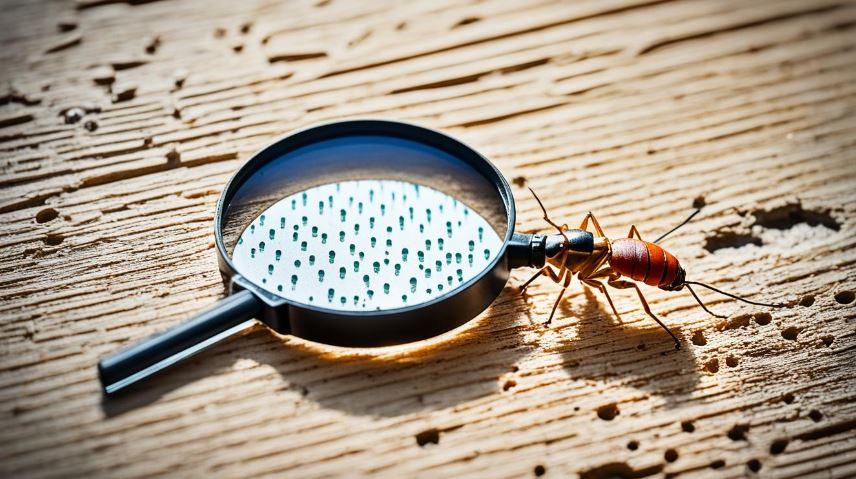Termites can cause significant damage to your home, making annual termite inspections crucial for early detection and prevention. Living in warm, moist climates or having an older home increases the risk of termite infestation, making regular inspections even more important. Termite inspections are especially vital in property transactions to ensure the integrity of the home and protect the interests of both buyers and sellers. By scheduling an annual termite inspection, you can take a proactive approach to safeguarding your home from costly damages caused by termites.
Key Takeaways:
- Annual termite inspections are essential for early detection and prevention of termite infestations.
- Living in warm, moist climates or having an older home increases the risk of termite activity.
- Termite inspections play a crucial role in property transactions to ensure home integrity and protect buyer and seller interests.
- Scheduling an annual termite inspection can help safeguard your home and prevent costly damages caused by termites.
- Regular inspections allow for a proactive approach to termite management.
Understanding the Threat of Termite Infestation
Termites pose a significant risk to your home due to their ability to consume and damage household wood. These small insects feed on cellulose, the main component of wood, and can quickly undermine the structural integrity of your home. If left unchecked, a termite infestation can lead to costly repairs and extensive damage.
One of the key reasons termites pose a risk to your home is their voracious appetite for wood. They have specialized enzymes in their digestive system that allow them to break down cellulose, making household wood a prime source of sustenance. This relentless consumption of wood can weaken structural beams, walls, and other wooden elements, compromising the stability of your home.
Moreover, termites are known for their ability to remain hidden and undetectable for long periods. This makes it crucial for homeowners to be proactive in identifying signs of termite activity. By understanding the threat of termite infestation, you can take the necessary steps to protect your home from these destructive pests.
Identifying High-Risk Regions for Termite Activity
While termites can be found in various regions across the United States, certain areas are considered high-risk for termite activity. Regions with warm and moist climates are particularly attractive to termites, as these conditions create an ideal environment for their survival and proliferation.
California, Hawaii, Texas, and Florida are among the states where termite activity is prevalent. The combination of high temperatures and ample moisture in these regions makes them hotspots for termite colonies to thrive. Homeowners residing in these high-risk areas should take extra precautions and remain vigilant in monitoring their homes for signs of termite infestation.
How Termites Consume and Damage Household Wood
Understanding how termites consume and damage household wood is crucial for early detection and mitigation. Termites have sharp jaws that allow them to chew through wood and create tunnels and galleries within the material. These tunnels serve as their nesting and foraging grounds, allowing them to establish a robust presence within the wooden structures of your home.
As termites consume wood, they leave behind visible signs of their activity. Some common indicators of termite damage include sagging floors, hollow-sounding wood, damaged or crumbling drywall, and small holes in wooden surfaces.
This image depicts the threat of termite infestation to the home, emphasizing the need for preventive measures and early detection.
Evaluating the Need for Regular Termite Inspections
Regular termite inspections are a critical aspect of maintaining the structural integrity and longevity of your property. By conducting regular inspections, you can evaluate the need for preventive measures and detect termite infestations at an early stage.
The Importance of Termite Inspections in Property Transactions
When it comes to property transactions, termite inspections are of utmost importance. Buyers and sellers alike benefit from thorough termite inspections as it ensures the property’s integrity and protects their interests. By identifying any existing termite activity or damage, both parties can make informed decisions and negotiate terms that reflect the property’s true condition.
The Annual Termite Inspection: A Preventative Measure
An annual termite inspection serves as a preventative measure to safeguard your property against termite damage. By scheduling a regular inspection, you can proactively detect any potential termite activity and take timely action to minimize the risk of extensive damage. A professional inspector will assess your property, identify any signs of termite presence, and recommend appropriate treatments or preventive measures.
Investing in an annual termite inspection not only protects your property but also provides you with peace of mind, knowing that you are taking proactive steps to maintain its value. Don’t wait until it’s too late; prioritize regular termite inspections as an essential part of your property maintenance routine.
Signs of a Termite Infestation to Watch Out For
Being aware of the signs of a termite infestation is vital for early detection and prompt action. By recognizing these signs, homeowners can take the necessary steps to seek professional termite treatment and prevent further damage to their properties. There are several visible indicators, audible clues, and physical evidence that can help identify the presence of termites.
Visible Indicators: Wings and Mud Tubes
One of the visible indicators of termite activity is the presence of discarded wings. Swarmers, the reproductive termites, shed their wings after finding a suitable location to establish a new colony. These wings may be found near windowsills, doors, or other entry points, indicating the presence of an active termite infestation.
Another visible indicator is the presence of mud tubes. Termites construct mud tubes as protective pathways between their nests and food sources. These tubes are typically made of soil, saliva, and excrement and can be found along walls, foundations, or other surfaces. Detecting mud tubes can be a strong indication of termite activity.
Audible Clues: Hollow Sound in Wooden Structures
An audible clue of termite presence is a hollow sound when tapping wooden structures. Termites consume wood from the inside out, creating tunnels and cavities that weaken the structure. When tapping or knocking on infested wood, homeowners may notice a distinct hollow sound, indicating the presence of termites inside.
Physical Evidence: Frass and Damaged Wood
Physical evidence such as frass, also known as termite droppings, can be an indication of an active termite infestation. Frass resembles small granules or sawdust and is often found near termite galleries or damaged wood. Additionally, visibly damaged wood, which appears gnawed or hollowed out, is a clear sign of termite activity.
Recognizing these visible indicators, audible clues, and physical evidence of termite infestation empowers homeowners to take immediate action. By promptly seeking professional termite treatment, homeowners can mitigate the risk of extensive damage and ensure the long-term protection of their homes.
Cost Considerations and Treatment Options for Termite Management
When it comes to termite management, cost considerations play a significant role in determining the best approach for homeowners. In this section, we will discuss the average costs of termite inspection and removal, as well as the options of DIY versus professional termite treatment.
Average Costs of Termite Inspection and Removal
Termite inspections are an important part of termite management, as they help identify any existing or potential termite infestations. On average, termite inspections can range from $50 to $250, depending on factors such as the location and size of the home. These inspections provide homeowners with valuable information about the extent of the infestation and the necessary steps for treatment.
Professional termite removal, on the other hand, involves the eradication of the termite colony and addressing any damage caused by the infestation. The cost of professional termite removal can vary depending on the severity of the infestation, with prices typically ranging from $230 to $1,000. It is important to consider the extent of the infestation and consult with a professional to determine the most appropriate treatment plan.
Do It Yourself vs. Professional Termite Treatment
Homeowners may consider DIY termite treatment as a cost-saving option. However, it is essential to weigh the potential risks and benefits before deciding on the best course of action. DIY termite treatment involves using over-the-counter solutions and products to address the infestation independently. While this option may be more budget-friendly, it may not provide the same level of effectiveness and thoroughness as professional treatment.
On the other hand, professional termite treatment is often recommended for severe infestations and for those seeking a comprehensive solution. Professional pest control companies have the knowledge, experience, and specialized equipment to effectively eliminate termites and prevent future infestations. While the initial cost may be higher than DIY treatments, professional treatment offers long-term peace of mind and protection for your home.
When deciding between DIY and professional termite treatment, it is crucial to consider the severity of the infestation, the cost implications, and the expertise required for effective termite management. Consulting with a pest control professional can help determine the best treatment option based on your specific situation and budget.
Conclusion
Annual termite inspections play a crucial role in protecting your home from the costly damages caused by termites. By understanding the threat of termite infestation, evaluating the need for regular inspections, and being aware of the signs of infestation, homeowners can take proactive measures to prevent and detect termite activity.
Regular termite inspections act as a preventative measure, allowing homeowners to identify and address any potential termite activity before it becomes a major problem. By scheduling an annual termite inspection, you can stay one step ahead of termites and minimize the risk of extensive damage to your property.
Cost considerations and treatment options should also be taken into account. While DIY termite treatment may seem like a cost-saving option, professional treatment is often more effective and thorough. It is important to weigh the potential risks and benefits before deciding between the two.
With regular inspections and timely actions, homeowners can safeguard their homes and ensure long-term protection against termite damage. Don’t wait for termites to cause extensive harm to your property. Invest in annual termite inspections to protect your home and maintain peace of mind.
FAQ
Do I need an annual termite inspection?
Yes, annual termite inspections are highly recommended to protect your home from termite damage. Regular inspections help with early detection and prevention of infestations, especially if you live in a warm, moist climate or have an older home.
Why do termites pose a risk to my home?
Termites can consume and damage the wood in your home, which can undermine its structural integrity. This can result in costly repairs and compromise the safety of your property.
How can I identify high-risk regions for termite activity?
Certain regions, like California, Hawaii, Texas, and Florida, are considered high-risk areas for termite activity due to their warm and moist climates. Living in these areas increases the likelihood of termite infestations.
How do termites consume and damage household wood?
Termites feed on cellulose, which is the main component of wood. They can quickly chew through wooden structures and cause extensive damage over time, compromising the integrity of your home.
Why are regular termite inspections important in property transactions?
Termite inspections are crucial in property transactions to ensure the integrity of the home. They protect the interests of both buyers and sellers by identifying any termite infestations or damage that may affect the value or safety of the property.
How does an annual termite inspection serve as a preventative measure?
Scheduling an annual termite inspection allows you to be proactive in safeguarding your home from costly termite damage. It helps to detect any potential termite activity early on, so appropriate measures can be taken to prevent further damage.
What are the visible indicators of a termite infestation?
Visible indicators include discarded wings and mud tubes near the foundation of your home.
How can I identify termite presence through audible clues?
A hollow sound when tapping wooden structures, such as walls or furniture, can indicate termite presence.
What are the physical evidence of a termite infestation?
Physical evidence includes frass (termite droppings) and visibly damaged wood, which can confirm the presence of termites in your home.
What are the average costs of termite inspection and removal?
Termite inspections can range from $50 to $250, depending on the location and size of your home. Professional termite removal costs between $230 and $1,000, depending on the severity of the infestation.
Should I opt for do-it-yourself or professional termite treatment?
While DIY termite treatment may seem cost-effective, professional treatment is often more effective and thorough. It’s important to consider the potential risks and benefits before deciding on the most suitable option for your specific situation.










